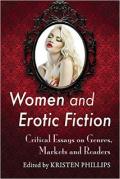 Simon Hardy's essay in this volume compares the "male tradition of pornographic writing" which made "use of a female narrative voice" to "erotic fiction and memoirs [...] that are genuinely written by women" in order to discover whether "female authors are producing new forms of erotica or simply assimilating patterns of erotic discourse established by the centuries-old tradition of male writers, often masquerading as female autobiographers" (25).
Simon Hardy's essay in this volume compares the "male tradition of pornographic writing" which made "use of a female narrative voice" to "erotic fiction and memoirs [...] that are genuinely written by women" in order to discover whether "female authors are producing new forms of erotica or simply assimilating patterns of erotic discourse established by the centuries-old tradition of male writers, often masquerading as female autobiographers" (25).
Naturally, he has had to be selective about the number of texts he could discuss in his essay and he acknowleges "right from the outset that the selection of other examples might well lead to different conclusions" (25). This is, I think, a very important acknowledgement. I can't speak about "erotic fiction and memoirs" because that's not an area of literature about which I have much knowledge, but certainly the field of romance fiction is extremely large and very varied and it's quite possible for conclusions which are correct about a certain subset of romances to be inapplicable to many others: one should therefore be very wary before extrapolating from a small number of texts, particularly if one cannot be certain that they are representative of the diversity of the field.
Hardy begins with a very brief overview of male-authored erotic fiction, focussing on John Clelland's Fanny Hill. He observes that:
Cleland's writing represented men and women as equally lascivious. Later, when "respectable" Victorian authorities established the notion of the passionless female, dissident pornographers opposed it by invoking the earlier tradition of female incontinence, but now with a new element: that this underlying female wantonness had to be brought forth as the submissive response to male sexual initiative. (27)
The much more recent Black Lace erotic imprint, although it had a "tag line of 'erotic fiction by women and for women'" (29), would appear to have followed in this Victorian tradition:
Black Lace fictions are stories of female sexual discovery, of women becoming active, pleasure seeking subjects. However, the goal of pleasure is usually attained only when the woman's social self finally yields to the natural lust residing in her body, as it responds to the agency of male sexual conquest. Female liberation is attained only in the act of submission. (31)
Hardy argues that Fifty Shades of Grey is "a hybridization of romance and pornography" (34). [This is an insight explored by Jodi McAlister in her 2013 paper "Breaking the Hard Limits: Romance, Pornography, and Genre in the Fifty Shades trilogy" (which can be found online, for free, here).] Like the (majority of?) Black Lace books, it would seem to follow in the Victorian pornographic tradition:
While Christian's sexuality is elaborately accounted for, Ana's response to and identification with the submissive role is taken for granted; described in endless detail yet never explained, as if it were latent in her nature, or simply because she really is a blank slate to be inscribed by her lover. [...] it is above all in this fundamental essentialist silence that James' text most crucially bears the hallmark of the male tradition of pornographic writing referred to above. (39)
-----
Hardy, Simon. "From Black Lace to Shades of Grey: The Interpellation of the 'Female Subject' into Erotic Discourse". Women and Erotic Fiction: Critical Essays on Genres, Markets and Readers. Ed. Kristen Phillips. Jefferson, North Carolina: McFarland 2015. 25-41.
